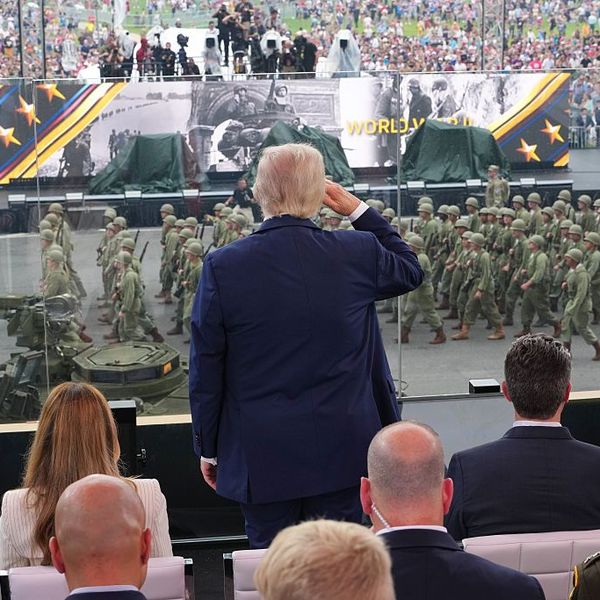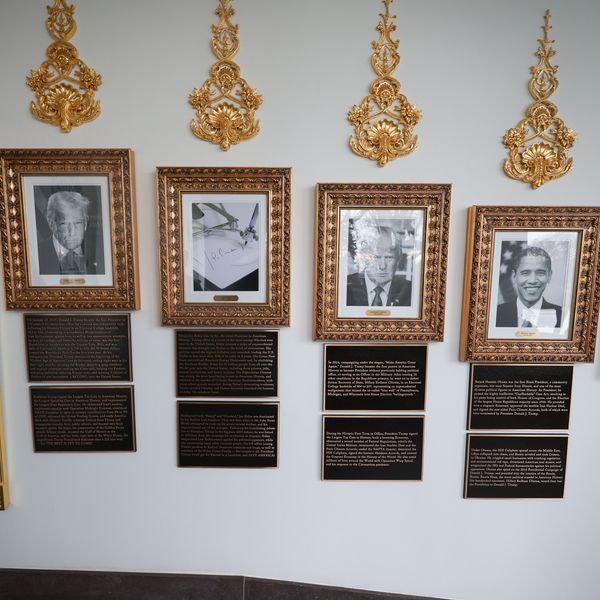
Sculpture depicting St. George slaying the dragon. The dragon is created from fragments of Soviet SS-20 and United States Pershing nuclear missiles. (Photo: UN/Milton Grant)
Slaying the Atomic Dragon: In Favor of the Treaty on the Prohibition of Nuclear Weapons
The world has spoken and the momentum toward complete nuclear abolition has shifted.
Today, September 26, is the International Day for the Total Abolition of Nuclear Weapons.
This day, first proclaimed by the United Nations General Assembly in 2013, draws attention to the international commitment to global nuclear disarmament by the majority of the world's nations as expressed in Article 6 of the Nuclear Non-Proliferation Treaty. It also highlights the lack of progress by the nine nuclear nations who hold the rest of the world hostage with their nuclear arsenals.
Albert Einstein said in 1946, "The unleashed power of the atom has changed everything save our mode of thinking and thus we drift toward unparalleled catastrophe."
This drift has perhaps never been more perilous than at the present time. With careless rhetoric of threatened use of nuclear weapons, fire and fury, and total destruction of other nations, the world has recognized that there are no right hands to be on the nuclear button. Total abolition of nuclear weapons is the only response.
Global nuclear disarmament has been a goal of the United Nations since its inception in 1945. With the passage of the Nuclear Non-Proliferation Treaty in 1970, the world's nuclear nations committed to work in "good faith" eliminate all nuclear weapons. The NPT treaty which is been a cornerstone of nuclear disarmament lacked the legal framework to achieve this goal. This reality in a world with 15,000 nuclear weapons coupled with the recognition of the catastrophic humanitarian consequences if nuclear weapons are ever used again has coalesced a global movement of civil society, indigenous peoples, victims of atomic attacks and testing, in a global campaign focused on the unacceptability of the existence and use of nuclear weapons under any circumstances.
This multi-year process has resulted in the Treaty on the Prohibition of Nuclear Weapons which was adopted at the United Nations on July 7, 2017 and provides the legal framework necessary to achieve the abolition of nuclear weapons.
At the opening day of the UN General Assembly last week on September 20, the Treaty was opened for signature. There have now been 53 nations who have signed the Treaty, and three who have ratified the Treaty. When 50 nations have finally ratified or formally adopted the Treaty it will go into force 90 days thereafter thus making nuclear weapons illegal to possess, stockpile, use or threaten to use, test, develop or transfer, just as all other weapons of mass destruction have been.
The world has spoken and the momentum toward complete nuclear abolition has shifted. The process is unstoppable. Each of us and our nation has a role to play in bringing forth this reality. Each of us must ask what is our role in this effort.
An Urgent Message From Our Co-Founder
Dear Common Dreams reader, The U.S. is on a fast track to authoritarianism like nothing I've ever seen. Meanwhile, corporate news outlets are utterly capitulating to Trump, twisting their coverage to avoid drawing his ire while lining up to stuff cash in his pockets. That's why I believe that Common Dreams is doing the best and most consequential reporting that we've ever done. Our small but mighty team is a progressive reporting powerhouse, covering the news every day that the corporate media never will. Our mission has always been simple: To inform. To inspire. And to ignite change for the common good. Now here's the key piece that I want all our readers to understand: None of this would be possible without your financial support. That's not just some fundraising cliche. It's the absolute and literal truth. We don't accept corporate advertising and never will. We don't have a paywall because we don't think people should be blocked from critical news based on their ability to pay. Everything we do is funded by the donations of readers like you. Will you donate now to help power the nonprofit, independent reporting of Common Dreams? Thank you for being a vital member of our community. Together, we can keep independent journalism alive when it’s needed most. - Craig Brown, Co-founder |
Today, September 26, is the International Day for the Total Abolition of Nuclear Weapons.
This day, first proclaimed by the United Nations General Assembly in 2013, draws attention to the international commitment to global nuclear disarmament by the majority of the world's nations as expressed in Article 6 of the Nuclear Non-Proliferation Treaty. It also highlights the lack of progress by the nine nuclear nations who hold the rest of the world hostage with their nuclear arsenals.
Albert Einstein said in 1946, "The unleashed power of the atom has changed everything save our mode of thinking and thus we drift toward unparalleled catastrophe."
This drift has perhaps never been more perilous than at the present time. With careless rhetoric of threatened use of nuclear weapons, fire and fury, and total destruction of other nations, the world has recognized that there are no right hands to be on the nuclear button. Total abolition of nuclear weapons is the only response.
Global nuclear disarmament has been a goal of the United Nations since its inception in 1945. With the passage of the Nuclear Non-Proliferation Treaty in 1970, the world's nuclear nations committed to work in "good faith" eliminate all nuclear weapons. The NPT treaty which is been a cornerstone of nuclear disarmament lacked the legal framework to achieve this goal. This reality in a world with 15,000 nuclear weapons coupled with the recognition of the catastrophic humanitarian consequences if nuclear weapons are ever used again has coalesced a global movement of civil society, indigenous peoples, victims of atomic attacks and testing, in a global campaign focused on the unacceptability of the existence and use of nuclear weapons under any circumstances.
This multi-year process has resulted in the Treaty on the Prohibition of Nuclear Weapons which was adopted at the United Nations on July 7, 2017 and provides the legal framework necessary to achieve the abolition of nuclear weapons.
At the opening day of the UN General Assembly last week on September 20, the Treaty was opened for signature. There have now been 53 nations who have signed the Treaty, and three who have ratified the Treaty. When 50 nations have finally ratified or formally adopted the Treaty it will go into force 90 days thereafter thus making nuclear weapons illegal to possess, stockpile, use or threaten to use, test, develop or transfer, just as all other weapons of mass destruction have been.
The world has spoken and the momentum toward complete nuclear abolition has shifted. The process is unstoppable. Each of us and our nation has a role to play in bringing forth this reality. Each of us must ask what is our role in this effort.
Today, September 26, is the International Day for the Total Abolition of Nuclear Weapons.
This day, first proclaimed by the United Nations General Assembly in 2013, draws attention to the international commitment to global nuclear disarmament by the majority of the world's nations as expressed in Article 6 of the Nuclear Non-Proliferation Treaty. It also highlights the lack of progress by the nine nuclear nations who hold the rest of the world hostage with their nuclear arsenals.
Albert Einstein said in 1946, "The unleashed power of the atom has changed everything save our mode of thinking and thus we drift toward unparalleled catastrophe."
This drift has perhaps never been more perilous than at the present time. With careless rhetoric of threatened use of nuclear weapons, fire and fury, and total destruction of other nations, the world has recognized that there are no right hands to be on the nuclear button. Total abolition of nuclear weapons is the only response.
Global nuclear disarmament has been a goal of the United Nations since its inception in 1945. With the passage of the Nuclear Non-Proliferation Treaty in 1970, the world's nuclear nations committed to work in "good faith" eliminate all nuclear weapons. The NPT treaty which is been a cornerstone of nuclear disarmament lacked the legal framework to achieve this goal. This reality in a world with 15,000 nuclear weapons coupled with the recognition of the catastrophic humanitarian consequences if nuclear weapons are ever used again has coalesced a global movement of civil society, indigenous peoples, victims of atomic attacks and testing, in a global campaign focused on the unacceptability of the existence and use of nuclear weapons under any circumstances.
This multi-year process has resulted in the Treaty on the Prohibition of Nuclear Weapons which was adopted at the United Nations on July 7, 2017 and provides the legal framework necessary to achieve the abolition of nuclear weapons.
At the opening day of the UN General Assembly last week on September 20, the Treaty was opened for signature. There have now been 53 nations who have signed the Treaty, and three who have ratified the Treaty. When 50 nations have finally ratified or formally adopted the Treaty it will go into force 90 days thereafter thus making nuclear weapons illegal to possess, stockpile, use or threaten to use, test, develop or transfer, just as all other weapons of mass destruction have been.
The world has spoken and the momentum toward complete nuclear abolition has shifted. The process is unstoppable. Each of us and our nation has a role to play in bringing forth this reality. Each of us must ask what is our role in this effort.

